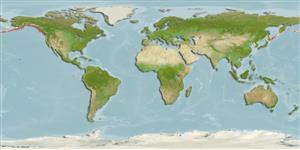>
Perciformes/Zoarcoidei (Eelpouts and pricklebacks) >
Stichaeidae (Pricklebacks) > Xiphisterinae
Etymology: Anoplarchus: Greek, ana = up + Greek, oplon = shield + Greek, archos = anus (Ref. 45335).
More on authors: Gilbert & Burke.
Environment: milieu / climate zone / depth range / distribution range
Écologie
marin démersal; profondeur 1 - 30 m (Ref. 2850). Temperate
Eastern Pacific: Aleutian Islands, Alaska to Arena Cove, Mendocino County, northern California, USA.
Taille / Poids / Âge
Maturity: Lm ? range ? - ? cm
Max length : 12.0 cm TL mâle / non sexé; (Ref. 2850)
Description synthétique
Morphologie | Morphométrie
Épines dorsales (Total): 57 - 64; Rayons mous dorsaux (Total): 0; Épines anales 0; Rayons mous anaux: 40 - 46; Vertèbres: 62 - 68. Dorsal well notched but joined to caudal; caudal rounded; pectorals bluntly pointed (Ref. 6885). Dark, or with a broken or variegated dark and light patterns usually with dark and light bars accentuating each other across jaw; frequently dark markings near anterior portion of dorsal fin and on the posterior margin of each gill cover; rarely individuals partly or completely bright red (Ref. 6885).
Facultative air-breathing (Ref. 126274); Prefers subtidal areas among rocks (Ref. 2850) and algae to depths of 30 meters (Ref. 51666).
Life cycle and mating behavior
Maturité | Reproduction | Frai | Œufs | Fécondité | Larves
Eschmeyer, W.N., E.S. Herald and H. Hammann, 1983. A field guide to Pacific coast fishes of North America. Boston (MA, USA): Houghton Mifflin Company. xii+336 p. (Ref. 2850)
Statut dans la liste rouge de l'IUCN (Ref. 130435)
Menace pour l'homme
Harmless
Utilisations par l'homme
Aquarium: Aquariums publics
Plus d'informations
Noms communsSynonymesMétabolismePrédateursÉcotoxicologieReproductionMaturitéFraiRassemblement de ponteFéconditéŒufsDéveloppement de l'œuf
Taille/ÂgeCroissanceLongueur-poidsLongueur-longueurFréquences de longueursMorphométrieMorphologieLarvesDynamique des populations larvairesRecrutementAbondanceBRUVS
RéférencesAquacultureProfil d'aquacultureSouchesGénétiqueElectrophoresesHéritabilitéPathologiesTraitementNutrientsMass conversion
CollaborateursImagesStamps, Coins Misc.SonsCiguateraVitesseType de nageSurface branchialeOtolithesCerveauxVision
Outils
Articles particuliers
Télécharger en XML
Sources Internet
Estimates based on models
Preferred temperature (Ref.
123201): 4.7 - 12.2, mean 7.3 °C (based on 438 cells).
Phylogenetic diversity index (Ref.
82804): PD
50 = 0.7500 [Uniqueness, from 0.5 = low to 2.0 = high].
Bayesian length-weight: a=0.00389 (0.00180 - 0.00842), b=3.12 (2.94 - 3.30), in cm total length, based on all LWR estimates for this body shape (Ref.
93245).
Niveau trophique (Ref.
69278): 2.7 ±0.2 se; based on size and trophs of closest relatives
Résilience (Ref.
120179): Milieu, temps minimum de doublement de population : 1,4 à 4,4 années (Preliminary K or Fecundity.).
Fishing Vulnerability (Ref.
59153): Low vulnerability (10 of 100).
